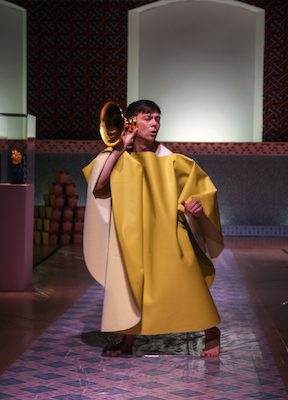The weather outside was uninviting — one of those cold Montréal spring days, wet, damp and unforgiving. Inside the Agora, things were decidedly warmer and more engaging as Sylvain Émard returned to the stage after an absence of fifteen years, bringing all of his refined artistry to the occasion, channelled through his own dancing body. I was left in wonder at the softness and unobtrusiveness of this solo performance. The solitary, fragile and vulnerable soul that Émard invokes is meted out with fine delineation and extreme quietude.
Once Émard comes out of the shadows, he stands stock-still in the opening minutes of the performance in a square of light. His great, sad, motionless face looks out, seeing what’s before him; only his eyes shift gently. That sad face, worn by time, suggests melancholia and eternity. What Émard embodies, after these years away from performing, is a wonderful embrace of patience in the face of adversity, and, in his relaxed and gentle stance, a power to endure. While he may be better known today for the entertaining and public-friendly Continental events he creates throughout the country and internationally (and why not?), it’s this new work, Le chant des sirènes, that reflects a deeply personal vision that’s much welcome.
Low, grounded travelling movements that cover the open space, linked indelibly to his time in Jo Lechay’s marvellous company, are still key to his vocabulary, as are some finely posed details, such as the marionette tilts of his head or when spiralling, the cupped, open-palmed hands to his ears and face. There are brilliant sections, when Émard creates a series of playful, tiny hops or an in-place little gig and transforms from man into an innocent child almost instantaneously, perhaps a nod to the “little man” evocations of another of his major influences, Jean-Pierre Perreault. He raises his hand, as if summoning some other soul to join him, but it’s in vain; he is alone.
Gradual eruptions of isolated movement, little flickers of engagement in his clavicle, shoulder blade and upper joints, were beautifully executed. I was at first surprised how familiar the precision of the movement was in this new work, but it reflected for me a reassuring sign: that major shifts in choreographic invention are not important, and a tabula rasa approach to creating material is not necessary; rather, as we age, certain qualities mature and deepen, become richer and are interpreted with greater clarity.
In Le chant des sirènes, Émard is channelling Homer’s the Odyssey. In that classic work, bird women lure sailors with their enchanting voices and song; this results in tragic consequences and demise on the sea. Odysseus, the protagonist of the Odyssey, for his part, has his sailors plug his ears with beeswax and tie him to a mast regardless of his protestations. Émard’s technical collaborators reinforce this fraught perspective. Martin Tétreault’s pulsing score is industrial music at its best, with not a hint of lyrical persuasion. It builds and bores into the skull, in the best way. When all goes temporarily silent, I find my mind and body relax, but it’s just a tease, as the electronic noise machine’s volume re-amplifies and we’re asunder once again. Richard Lacroix’s minimalist set is composed of one long oblong bench and an immense, tilted rust-looking pillar, on which discreet video projections are displayed (one reflects, in real time, Émard’s progress across the stage). There are some magical moments, in terms of the lighting, designed by André Rioux. One particular section that elicited gasps from the audience is when Émard is caught in a blood-red flood of light, giving an illusion of movement while he seems transfixed by danger and anticipation.
Over twenty years ago, in 1995, I wrote a review for another publication about another solo performance of Émard’s, Des siècles avec vous, detailing aspects of performance that remain true today: how he’s able to elicit our attention and, with his calm, centred stillness, can be delicate, strong and compassionate. In this work, even when he appears to be helpless, buffeted by unseen forces, he persists. Émard’s a poet, with years of quiet contemplation under his belt. He’s the kind of sensitive, nuanced dance artist I feel we need today. As I stated a score of years ago, Émard, now in his early sixties, has an uncanny ability to look supremely at ease onstage. There is something very tender in the way he chooses to present himself in this current work. ‘Stripped back’ is a term that comes to mind, but he’s hitting at something else, layered, nuanced, reflective and mutable, a life lived. Not a manufactured presence, but an in-tune and highly accessible human depiction.
Tagged: Contemporary, Solo, Montréal , QC





